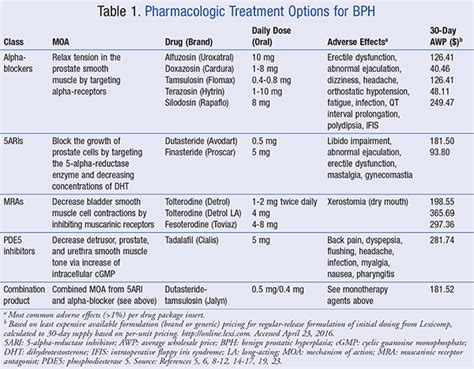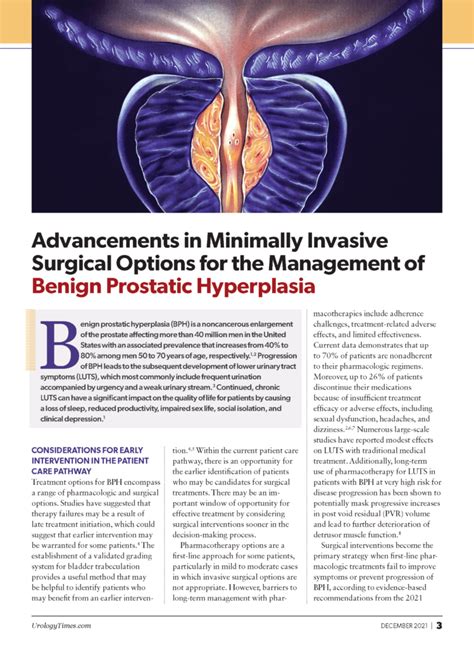Intro
Discover 5 effective BPH treatment options, including medications, lifestyle changes, and surgical procedures, to alleviate benign prostatic hyperplasia symptoms and improve prostate health, reducing urinary issues and enhancing overall well-being.
Benign prostatic hyperplasia, or BPH, is a condition where the prostate gland becomes enlarged, leading to various urinary symptoms such as difficulty starting urination, weak urine flow, and frequent urination. As men age, the risk of developing BPH increases, with approximately 50% of men experiencing symptoms by the age of 50. Fortunately, there are several effective BPH treatment options available, ranging from lifestyle modifications to surgical interventions.
The importance of addressing BPH symptoms cannot be overstated, as untreated BPH can lead to complications such as urinary tract infections, bladder stones, and kidney damage. Moreover, BPH can significantly impact a man's quality of life, causing embarrassment, anxiety, and sleep disturbances. By understanding the available treatment options and seeking medical attention, men can alleviate their symptoms and regain control over their urinary health.
BPH treatment is a multifaceted approach that takes into account the severity of symptoms, overall health, and personal preferences. While some men may require immediate medical attention, others may benefit from conservative management or alternative therapies. In this article, we will delve into the various BPH treatment options, exploring their benefits, risks, and effectiveness. By providing a comprehensive overview of BPH treatment, we aim to empower men with the knowledge they need to make informed decisions about their health.
Introduction to BPH Treatment Options

BPH treatment options can be broadly categorized into lifestyle modifications, medications, minimally invasive therapies, and surgical interventions. Each approach has its advantages and disadvantages, and the most effective treatment plan often involves a combination of these options. By understanding the different treatment modalities, men can work with their healthcare providers to develop a personalized plan that addresses their unique needs and concerns.
Lifestyle Modifications for BPH
Lifestyle modifications are often the first line of defense against BPH symptoms. These changes can help alleviate mild to moderate symptoms and improve overall urinary health. Some effective lifestyle modifications for BPH include: * Limiting fluid intake in the evening to reduce nighttime urination * Avoiding caffeine and alcohol, which can exacerbate urinary symptoms * Engaging in regular exercise to improve bladder control and overall health * Practicing stress-reducing techniques, such as meditation or deep breathing, to manage anxiety and urgency * Avoiding medications that can worsen BPH symptoms, such as decongestants and antihistaminesMedications for BPH

Medications are a common treatment option for BPH, offering relief from symptoms and improving urinary flow. The most commonly prescribed medications for BPH include:
- Alpha-blockers, which relax the muscles in the prostate and bladder neck, improving urine flow
- 5-alpha-reductase inhibitors, which shrink the prostate gland and reduce symptoms
- Phosphodiesterase-5 inhibitors, which improve urine flow and reduce symptoms in men with erectile dysfunction
- Anticholinergics, which help control urgency and frequency by relaxing the bladder muscle
Minimally Invasive Therapies for BPH
Minimally invasive therapies offer a middle ground between medications and surgery, providing effective symptom relief with fewer side effects. Some popular minimally invasive therapies for BPH include: * Transurethral microwave thermotherapy (TUMT), which uses microwave energy to heat and shrink the prostate tissue * Transurethral needle ablation (TUNA), which uses radiofrequency energy to heat and destroy excess prostate tissue * Laser therapy, which uses high-energy laser beams to vaporize or remove excess prostate tissueSurgical Interventions for BPH

Surgical interventions are often reserved for men with severe BPH symptoms or those who have not responded to other treatments. The most common surgical procedures for BPH include:
- Transurethral resection of the prostate (TURP), which involves removing excess prostate tissue through the urethra
- Open prostatectomy, which involves removing the entire prostate gland through an incision in the abdomen
- Laparoscopic prostatectomy, which uses a minimally invasive approach to remove the prostate gland
- Robotic prostatectomy, which uses a robotic system to remove the prostate gland with enhanced precision and control
Alternative Therapies for BPH
Alternative therapies, such as herbal supplements and acupuncture, have gained popularity in recent years as men seek complementary approaches to managing their BPH symptoms. While some alternative therapies may offer benefits, it is essential to approach these options with caution and consult with a healthcare provider before using them. Some popular alternative therapies for BPH include: * Saw palmetto, which may help reduce prostate size and alleviate symptoms * Pygeum, which may help improve urine flow and reduce symptoms * Acupuncture, which may help reduce stress and improve urinary functionConclusion and Future Directions

In conclusion, BPH treatment is a complex and multifaceted field that requires a comprehensive approach. By understanding the various treatment options, including lifestyle modifications, medications, minimally invasive therapies, and surgical interventions, men can work with their healthcare providers to develop a personalized plan that addresses their unique needs and concerns. As research continues to advance, new and innovative treatments are emerging, offering improved symptom relief and enhanced quality of life for men with BPH.
We invite you to share your thoughts and experiences with BPH treatment in the comments section below. Have you tried any of the treatment options discussed in this article? What benefits or challenges have you encountered? By sharing your story, you can help others better understand the complexities of BPH treatment and make informed decisions about their health.
What are the most common symptoms of BPH?
+The most common symptoms of BPH include difficulty starting urination, weak urine flow, frequent urination, and nocturia (waking up at night to urinate).
Can BPH be prevented?
+While BPH cannot be completely prevented, maintaining a healthy lifestyle, including a balanced diet, regular exercise, and stress management, may help reduce the risk of developing BPH.
What are the potential risks and complications of BPH surgery?
+Potential risks and complications of BPH surgery include bleeding, infection, urinary incontinence, and erectile dysfunction. However, these risks can be minimized by choosing an experienced surgeon and following post-operative instructions carefully.
Can alternative therapies, such as herbal supplements, help alleviate BPH symptoms?
+Some alternative therapies, such as saw palmetto and pygeum, may help alleviate BPH symptoms. However, it is essential to consult with a healthcare provider before using these therapies, as they may interact with other medications or have side effects.
How can I manage my BPH symptoms and improve my quality of life?
+Managing BPH symptoms and improving quality of life involves a combination of lifestyle modifications, medications, and alternative therapies. It is essential to work with a healthcare provider to develop a personalized treatment plan that addresses your unique needs and concerns.
